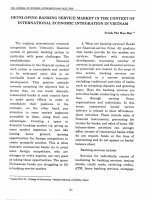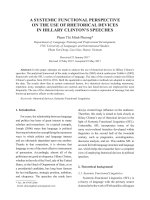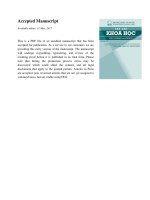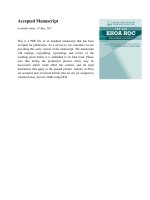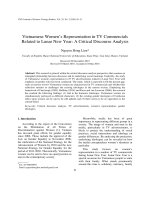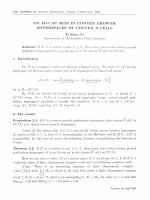DSpace at VNU: Vietnamese Model of Journalism in the Age of Integration and its Effects to the Civil Society and Democracy in Vietnam
Bạn đang xem bản rút gọn của tài liệu. Xem và tải ngay bản đầy đủ của tài liệu tại đây (210.69 KB, 9 trang )
������������������������������������������������������������������������������������������������������������������������������������������������������������������������������������������������������������������������������������������������������������������������������������������������������������������������������������������������������������������������������������������������������������������������������������������������������������������������������������������������������������������������������������������������������������������������������������������������������������������������������������������������������������������������������������������������������������������������������������������������������������������������������������������������������������������������������������������������������������������������������������������������������������������������������������������������������������������������������������������������������������������������������������������������������������������������������������������������������������������������������������������������������������������������������������������������������������������������������������������������������������������������������������������������������������������������������������������������������������������������������������������������������������������������������������������������������������������������������������������������������������������������������������������������������������������������������������������������������������������������������������������������������������������������������������������������������������������������������������������������������������������������������������������������������������������������������������������������������������������������������������������������������������������������������������������������������������������������������������������������������������������������������������������������������������������������������������������������������������������������������������������������������������������������������������������������������������������������������������������������������������������������������������������������������������������������������������������������������������������������������������������������������������������������������������������������������������������������������������������������������������������������������������������������������������������������������������������������������������������������������������������������������������������������������������������������������������������������������������������������������������������������������������������������������������������������������������������������������������������������������������������������������������������������������������������������������������������������������������������������������������������������������������������������������������������������������������������������������������������������������������������������������������������������������������������������������������������������������������������������������������������������������������������������������������������������������������������������������������������������������������������������������������������������������������������������������������������������������������������������������������������������������������������������������������������������������������������������������������������������������������������������������������������������������������������������������������������������������������������������������������������������������������������������������������������������������������������������������������������������������������������������������������������������������������������������������������������������������������������������������������������������������������������������������������������������������������������������������������������������������������������������������������������������������������������������������������������������������������������������������������������������������������������������������������������������������������������������������������������������������������������������������������������������������������������������������������������������������������������������������������������������������������������������������������������������������������������������������������������������������������������������������������������������������������������������������������������������������������������������������������������������������������������������������������������������������������������������������������������������������������������������������������������������������������������������������������������������������������������������������������������������������������������������������������������������������������������������������������������������������������������������������������������������������������������������������������������������������������������������������������������������������������������������������������������������������������������������������������������������������������������������������������������������������������������������������������������������������������������������������������������������������������������������������������������������������������������������������������������������������������������������������������������������������������������������������������������������������������������������������������������������������������������������������������������������������������������������������������������������������������������������������������������������������������������������������������������������������������������������������������������������������������������������������������������������������������������������������������������������������������������������������������������������������������������������������������������������������������������������������������������������������������������������������������������������������������������������������������������������������������������������������������������������������������������������������������������������������������������������������������������������������������������������������������������������������������������������������������������������������������������������������������������������������������������������������������������������������������������������������������������������������������������������������������������������������������������������������������������������������������������������������������������������������������������������������������������������������������������������������������������������������������������������������������������������������������������������������������������������������������������������������������������������������������������������������������������������������������������������������������������������������������������������������������������������������������������������������������������������������������������������������������������������������������������������������������������������������������������������������������������������������������������������������������������������������������������������������������������������������������������������������������������������������������������������������������������������������������������������������������������������������������������������������������������������������������������������������������������������������������������������������������������������������������������������������������������������������������������������������������������������������������������������������������������������������������������������������������������������������������������������������������������������������������������������������������������������������������������������������������������������������������������������������������������������������������������������������������������������������������������������������������������������������������������������������������������������������������������������������������������������������������������������������������������������������������������������������������������������������������������������������������������������������������������������������������������������������������������������������������������������������������������������������������������������������������������������������������������������������������������������������������������������������������������������������������������������������������������������������������������������������������������������������������������������������������������������������������������������������������������������������������������������������������������������������������������������������������������������������������������������������������������������������������������������������������������������������������������������������������������������������������������������������������������������������������������������������������������������������������������������������������������������������������������������������������������������������������������������������������������������������������������������������������������������������������������������������������������������������������������������������������������������������������������������������������������������������������������������������������������������������������������������������������������������������������������������������������������������������������������������������������������������������������������������������������������������������������������������������������������������������������������������������������������������������������������������������������������������������������������������������������������������������������������������������������������������������������������������������������������������������������������������������������������������������������������������������������������������������������������������������������������������������������������������������������������������������������������������������������������������������������������������������������������������������������������������������������������������������������������������������������������������������������������������������������������������������������������������������������������������������������������������������������������������������������������������������������������������������������������������������������������������������������������������������������������������������������������������������������������������������������������������������������������������������������������������������������������������������������������������������������������������������������������������������������������������������������������������������������������������������������������������������������������������������������������������������������������������������������������������������������������������������������������������������������������������������������������������������������������������������������������������������������������������������������������������������������������������������������������������������������������������������������������������������������������������������������������������������������������������������������������������������������������������������������������������������������������������������������������������������������������������������������������������������������������������������������������������������������������������������������������������������������������������������������������������������������������������������������������������������������������������������������������������������������������������������������������������������������������������������������������������������������������������������������������������������������������������������������������������������������������������������������������������������������������������������������������������������������������������������������������������������������������������������������������������������������������������������������������������������������������������������������������������������������������������������������������������������������������������������������������������������������������������������������������������������������������������������������������������������������������������������������������������������������������������������������������������������������������������������������������������������������������������������������������������������������������������������������������������������������������������������������������������������������������������������������������������������������������������������������������������������������������������������������������������������������������������������������������������������������������������������������������������������������������������������������������������������������������������������������������������������������������������������������������������������������������������������������������������������������������������������������������������������������������������������������������������������������������������������������������������������������������������������������������������������������������������������������������������������������������������������������������������������������������������������������������������������������������������������������������������������������������������������������������������������������������������������������������������������������������������������������������������������������������������������������������������������������������������������������������������������������������������������������������������������������������������������������������������������������������������������������������������������������������������������������������������������������������������������������������������������������������������������������������������������������������������������������������������������������������������������������������������������������������������������������������������������������������������������������������������������������������������������������������������������������������������������������������������������������������������������������������������������������������������������������������������������������������������������������������������������������������������������������������������������������������������������������������������������������������������������������������������������������������������������������������������������������������������������������������������������������������������������������������������������������������������������������������������������������������������������������������������������������������������������������������������������������������������������������������������������������������������������������������������������������������������������������������������������������������������������������������������������������������������������������������������������������������������������������������������������������������������������������������������������������������������������������������������������������������������������������������������������������������������������������������������������������������������������������������������������������������������������������������������������������������������������������������������������������������������������������������������������������������������������������������������������������������������������������������������������������������������������������������������������������������������������������������������������������������������������������������������������������������������������������������������������������������������������������������������������������������������������������������������������������������������������������������������������������������������������������������������������������������������������������������������������������������������������������������������������������������������������������������������������������������������������������������������������������������������������������������������������������������������������������������������������������������������������������������������������������������������������������������������������������������������������������������������������������������������������������������������������������������������������������������������������������������������������������������������������������������������������������������������������������������������������������������������������������������������������������������������������������������������������������������������������������������������������������������������������������������������������������������������������������������������������������������������������������������������������������������������������������������������������������������������������������������������������������������������������������������������������������������������������������������������������������������������������������������������������������������������������������������������������������������������������������������������������������������������������������������������������������������������������������������������������������������������������������������������������������������������������������������������������������������������������������������������������������������������������������������������������������������������������������������������������������������������������������������������������������������������������������������������������������������������������������������������������������������������������������������������������������������������������������������������������������������������������������������������������������������������������������������������������������������������������������������������������������������������������������������������������������������������������������������������������������������������������������������������������������������������������������������������������������������������������������������������������������������������������������������������������������������������������������������������������������������������������������������������������������������������������������������������������������������������������������������������������������������������������������������������������������������������������������������������������������������������������������������������������������������������������������������������������������������������������������������������������������������������������������������������������������������������������������������������������������������������������������������������������������������������������������������������������������������������������������������������������������������������������������������������������������������������������������������������������������������������������������������������������������������������������������������������������������������������������������������������������������������������������������������������������������������������������������������������������������������������������������������������������������������������������������������������������������������������������������������������������������������������������������������������������������������������������������������������������������������������������������������������������������������������������������������������������������������������������������������������������������������������������������������������������������������������������������������������������������������������������������������������������������������������������������������������������������������������������������������������������������������������������������������������������������������������������������������������������������������������������������������������������������������������������������������������������������������������������������������������������������������������������������������������������������������������������������������������������������������������������������������������������������������������������������������������������������������������������������������������������������������������������������������������������������������������������������������������������������������������������������������������������������������������������������������������������������������������������������������������������������������������������������������������������������������������������������������������������������������������������������������������������������������������������������������������������������������������������������������������������������������������������������������������������������������������������������������������������������������������������������������������������������������������������������������������������������������������������������������������������������������������������������������������������������������������������������������������������������������������������������������������������������������������������������������������������������������������������������������������������������������������������������������������������������������������������������������������������������������������������������������������������������������������������������������������������������������������������������������������������������������������������������������������������������������������������������������������������������������������������������������������������������������������������������������������������������������������������������������������������������������������������������������������������������������������������������������������������������������������������������������������������������������������������������������������������������������������������������������������������������������������������������������������������������������������������������������������������������������������������������������������������������������������������������������������������������������������������������������������������������������������������������������������������������������������������������������������������������������������������������������������������������������������������������������������������������������������������������������������������������������������������������������������������������������������������������������������������������������������������������������������������������������������������������������������������������������������������������������������������������������������������������������������������������������������������������������������������������������������������������������������������������������������������������������������������������������������������������������������������������������������������������������������������������������������������������������������������������������������������������������������������������������������������������������������������������������������������������������������������������������������������������������������������������������������������������������������������������������������������������������������������������������������������������������������������������������������������������������������������������������������������������������������������������������������������������������������������������������������������������������������������������������������������������������������������������������������������������������������������������������������������������������������������������������������������������������������������������������������������������������������������������������������������������������������������������������������������������������������������������������������������������������������������������������������������������������������������������������������������������������������������������������������������������������������������������������������������������������������������������������������������������������������������������������������������������������������������������������������������������������������������������������������������������������������subsidies,
and
allowed
journalistic
organisations to seek other financial resources,
including those from advertisers and
subscribers. In order to attract more advertisers,
the key for journalism organisations, is to
capture
larger
audiences.
Commercial
competition - a new phenomenon, which did
not exist in Vietnamese journalism during the
subsidised period - emerged amongst
journalism organisations. For the first time,
Vietnamese journalism had to serve two
masters, the Party and the audience. The flow of
information was no longer one way, from
central government to the people, as it was
during the subsidised period, but influenced by
advertisers and audiences themselves.
The institutional arrangements of the
Communist Party Press system and the current
market-based Party Press system show clearly
that Vietnam’s journalism has evolved from a
one-way to a two-way communication system.
The masses are no longer merely the followers
and subjects of an information system, but
63
consumers and commodities in the marketplace: audiences. Consequently, capturing
larger audiences becomes an essential
imperative for any journalism organisation, as it
is the only way to fulfil both the political and
commercial demands of the current condition.
4. Conclusion
The Economic Renovation, as a switch
from the subsidised period to a socialist market
economy, has not only improved the economic
situation, and the living standards of the general
population in Vietnam, but also provided
significant impacts on media development, and
consequently, the civil society and democracy
in this country. However, as mentioned
previously, the assessment of the quality of
democracy always depends on the point of view
and the Western idea of democracy does not fit
well the circumstances in Vietnam. Therefore, in
terms of the role of journalism in strengthening
the civil society and democracy, in the specific
context of Vietnam at the transitional period
toward a socialist market economy, a new
theoretical model of journalism, a model
integrating both political and economic
dimensions should be considered.
References
[1] Siebert, F.S, Peterson, T., and Schramm, W., Four
theories of the press: The authoritarian, libertarian,
social responsibility, and Soviet Communist concepts
what the press should be and do. Urbana: University
of Illinois Press, 1963.
[2] Lambeth, E.B., Global media philosophies. In: J.C.
Merrill (ed.), Global Journalism: Survey of international
communication, New York: Longman, 1995.
[3] Huang, C., Transitional Media vs. Normative
Theories: Schramm, Altschull, and China, Journal of
Communication, September, (2003) 444.
[4] Schramm, W., The Soviet Communist Theory. In
Siebert (ed), Four theories of the Press, The
University of Illinois, (1963) 105.
[5] Huu Tho, Guidelines and policies of the VII Party
Congress's Resolution on enhancing the management
and control of journalism. In: The Commitee of
64
[6]
[7]
[8]
[9]
[10]
[11]
[12]
[13]
[14]
[15]
[16]
[17]
Đ.T.T. Hương / VNU Journal of Sciences, Social Sciences and Humanities 28, No.5E (2012) 57‐64
Central Ideology and Cuture and Ministry of Culture
and Information, Enhancing the quality and effects of
journalism and publishing, (1992) 62 (Translated
from Vietnamese).
Tran Quang Nhiep, Orientations for current journalistic
activities and managements in the market economy of
our country. Hanoi: The National Politics Publishing
House, 2002 (Translated from Vietnamese).
Le Dinh Dao, Guidelines for researching
commercial radio in Vietnam, A VOV project, 2003
(Translated from Vietnamese).
Tran Huu Quang, The landscape of media audiences.
HoChiMinh City: HoChiMinh City Publisher, 2002
(Translated from Vietnamese).
Laws of Journalism, Hanoi: The National Politics
Publishing House, 1989.
(Translated from
Vietanmese).
Laws of Journalism (Amended), Hanoi: The
National Politics Publishing House, 1999
(Translated from Vietnamese).
Renovation No.219/2005/QD-TTg of the Prime
Minister, 9 September 2005, on the Information
Strategy toward 2010. (Translated from
Vietnamese).
Do Muoi, Improving the quality of journalism and
strengthening the intellectual standards of the
population, Paper presented at The National
Journalistic and Publishing Conference, January
1992. Hanoi: The Ideology and Culture Publisher,
p.15-29 (Translated from Vietnamese).
Instruction No.08/CT-TW of the Secrectariat of the
CPV Central Committee, 31March 1992, Enhancing
the (Party) leadership and control in order to
improve the quality and effect of journalism and
publishing. (Translated from Vietnamese).
Instruction No.22-CT/TW of the Party Central Committee,
17 October 1997, continuing the renovation and enhancing
the leadership and control towards journalism and
publishing. (Translated from Vietnamese).
Busch, W. (ed.), The Asia Media Directory, Konrad
Adenauer Foundation (Singapore), 2004.
Dang Thi Thu Huong, National identities of
ASEAN journalism. In: Journalism: Theories and
Practices, Vol.4, Hanoi National University
Publisher, 2001. (Translated from Vietnamese).
Vietnamese Journalist Organisation, Social
obligations and citizen responsibilities of Vietnamse
journalists, Vietnamese Journalist Organisation,
1998 (Translated from Vietnamese).
[18] Huu Tho, The media landscape and responsibilities
during the period of industrialisation and
modernisation. In: Continuing to renovate and
strengthen media control and management. Hanoi:
The Commitee of Central Ideology and Cuture and
Ministry of Culture and Information, (1997) 51
(Translated from Vietnamese).
[19] Esterline, J.H., Vietnam in 1987: Steps towards
Rejuvenation, Asian Survey, Published by
University of California Press, 28 (1) (1988) 86.
[20] Hai Au, 2005. Review of the articles 'Things That
Must Be Done Immediately, 2005. VietnamNet,
Available
from:
/>?article_id=675652 [Accessed 9 September 2006].
(Translated from Vietnamese).
[21] Aschhoff, 2008. What role can local NGOs play to
support grassroots democracy in Vietnam?. Minor
“As the Worlds Turns” - Module 3 Field Study.
Available
from:
[Accessed 5
October 2008]
[22] Gunaratne, S.A., The Media in Asia: An Overview,
In: International Communication Gazette, vol. 61
(3-4) (1999) 197.
[23] Zelizer, B., Taking journalism seriously: News and
the Academy, Sage Publications, 2004.
[24] Hallin, D.C. and Mancini, P., Comparing Media
Systems: Three Models of media and politics,
Cambridge University Press, 2004.
[25] Dang Thi Thu Huong, Media control in the market
economy, Journal of Journalists, 1 (2001) 5
(Translated from Vietnamese).
[26] Do Xuan, 2005. Improving the Communist Party’s
Media Management in Journalistic organisations.
Journal for Building the Party, 6 (2005). Available from:
/>[Accessed 27 September 2006]; (Translated from
Vietnamese).
[27] Huu Tho, Thoughts on Professional Journalism.
Hanoi: The Education Publisher, 2000 (Translated
from Vietnamese).
[28] Moy, P. and Scheuffle, D. A., Media Effects on
Political and Social Trust, Journalism and Mass
Communication Quarterly, 77 (4) (2000) 744.
[29] Gunaratne, S.A., Freedom of the Press: A World
System
Perspective.
In:
International
Communication Gazette, vol. 64 (4) (2002) 343.
VNU Journal of Social Sciences and Humanities 28, No.5E (2012) 57‐64
57

